Facebook Inc. Marketing: A Detailed Analysis and Report
VerifiedAdded on 2023/03/23
|11
|3180
|65
Report
AI Summary
This report provides a comprehensive analysis of Facebook Inc.'s marketing strategies, user base, and revenue models. It explores the company's growth, user segmentation, and the factors contributing to its massive user base. The report delves into Facebook's business model, highlighting its transformation from a social network to an advertising platform and its primary revenue source: digital advertising. A PESTEL analysis examines the political, economic, social, technological, environmental, and legal factors influencing Facebook's operations, identifying both opportunities and threats. Furthermore, the report investigates Facebook's usefulness to advertisers and marketers, considering its impact on marketing information systems, segmentation, targeting, positioning, product/service design, pricing, distribution, and marketing communications. The analysis provides a detailed overview of Facebook's influence on the market and its strategic approaches.
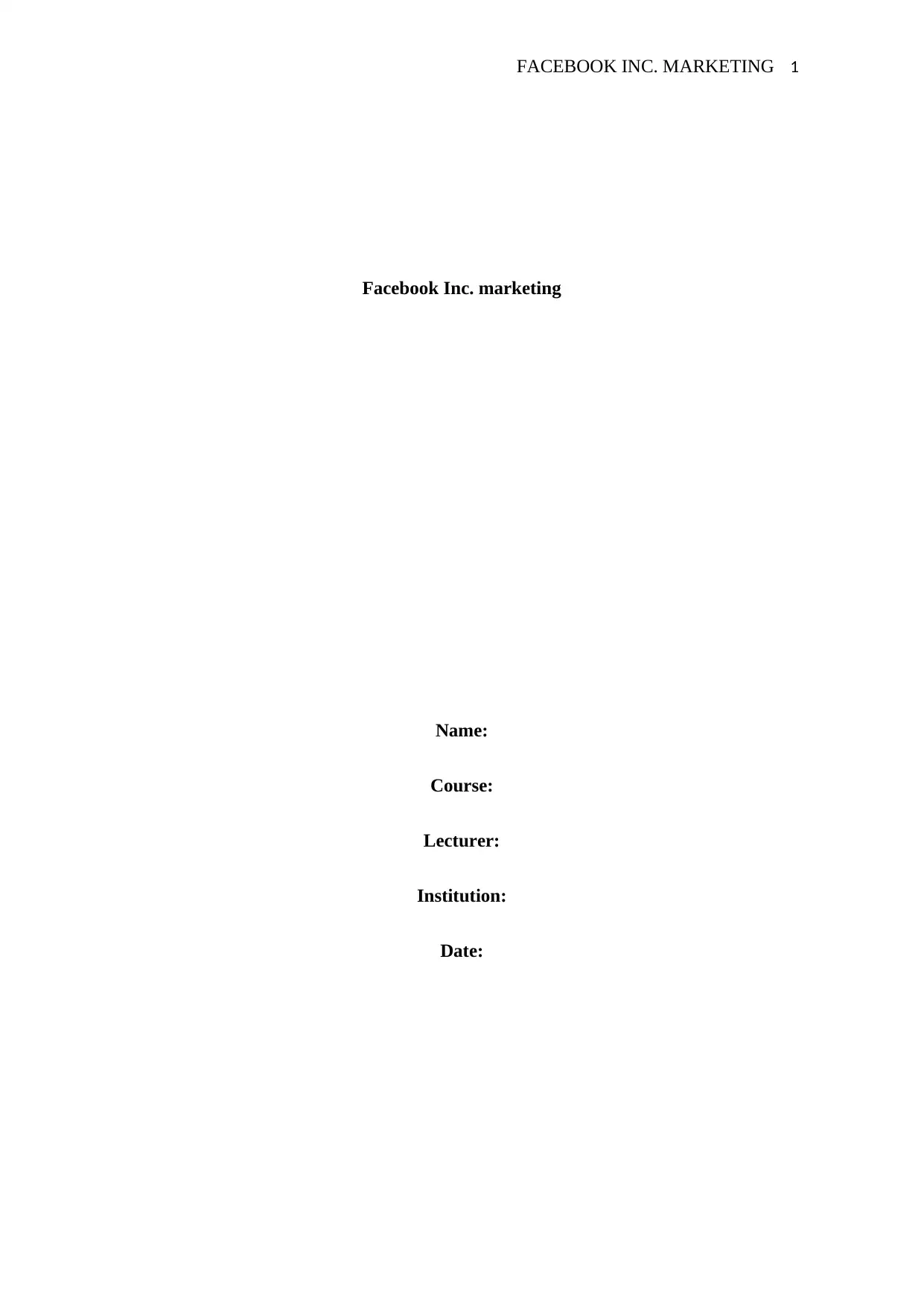
FACEBOOK INC. MARKETING 1
Facebook Inc. marketing
Name:
Course:
Lecturer:
Institution:
Date:
Facebook Inc. marketing
Name:
Course:
Lecturer:
Institution:
Date:
Paraphrase This Document
Need a fresh take? Get an instant paraphrase of this document with our AI Paraphraser
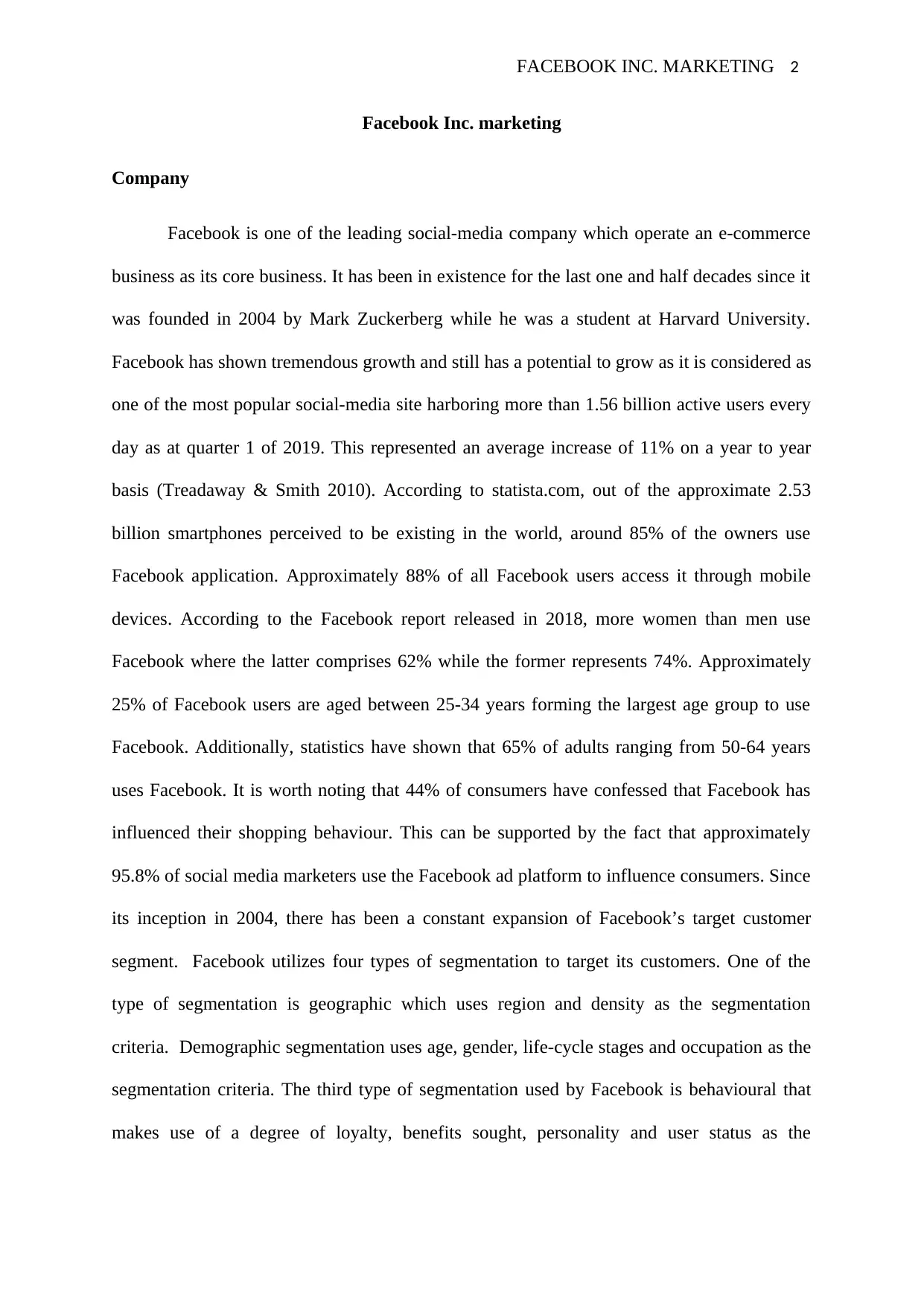
FACEBOOK INC. MARKETING 2
Facebook Inc. marketing
Company
Facebook is one of the leading social-media company which operate an e-commerce
business as its core business. It has been in existence for the last one and half decades since it
was founded in 2004 by Mark Zuckerberg while he was a student at Harvard University.
Facebook has shown tremendous growth and still has a potential to grow as it is considered as
one of the most popular social-media site harboring more than 1.56 billion active users every
day as at quarter 1 of 2019. This represented an average increase of 11% on a year to year
basis (Treadaway & Smith 2010). According to statista.com, out of the approximate 2.53
billion smartphones perceived to be existing in the world, around 85% of the owners use
Facebook application. Approximately 88% of all Facebook users access it through mobile
devices. According to the Facebook report released in 2018, more women than men use
Facebook where the latter comprises 62% while the former represents 74%. Approximately
25% of Facebook users are aged between 25-34 years forming the largest age group to use
Facebook. Additionally, statistics have shown that 65% of adults ranging from 50-64 years
uses Facebook. It is worth noting that 44% of consumers have confessed that Facebook has
influenced their shopping behaviour. This can be supported by the fact that approximately
95.8% of social media marketers use the Facebook ad platform to influence consumers. Since
its inception in 2004, there has been a constant expansion of Facebook’s target customer
segment. Facebook utilizes four types of segmentation to target its customers. One of the
type of segmentation is geographic which uses region and density as the segmentation
criteria. Demographic segmentation uses age, gender, life-cycle stages and occupation as the
segmentation criteria. The third type of segmentation used by Facebook is behavioural that
makes use of a degree of loyalty, benefits sought, personality and user status as the
Facebook Inc. marketing
Company
Facebook is one of the leading social-media company which operate an e-commerce
business as its core business. It has been in existence for the last one and half decades since it
was founded in 2004 by Mark Zuckerberg while he was a student at Harvard University.
Facebook has shown tremendous growth and still has a potential to grow as it is considered as
one of the most popular social-media site harboring more than 1.56 billion active users every
day as at quarter 1 of 2019. This represented an average increase of 11% on a year to year
basis (Treadaway & Smith 2010). According to statista.com, out of the approximate 2.53
billion smartphones perceived to be existing in the world, around 85% of the owners use
Facebook application. Approximately 88% of all Facebook users access it through mobile
devices. According to the Facebook report released in 2018, more women than men use
Facebook where the latter comprises 62% while the former represents 74%. Approximately
25% of Facebook users are aged between 25-34 years forming the largest age group to use
Facebook. Additionally, statistics have shown that 65% of adults ranging from 50-64 years
uses Facebook. It is worth noting that 44% of consumers have confessed that Facebook has
influenced their shopping behaviour. This can be supported by the fact that approximately
95.8% of social media marketers use the Facebook ad platform to influence consumers. Since
its inception in 2004, there has been a constant expansion of Facebook’s target customer
segment. Facebook utilizes four types of segmentation to target its customers. One of the
type of segmentation is geographic which uses region and density as the segmentation
criteria. Demographic segmentation uses age, gender, life-cycle stages and occupation as the
segmentation criteria. The third type of segmentation used by Facebook is behavioural that
makes use of a degree of loyalty, benefits sought, personality and user status as the
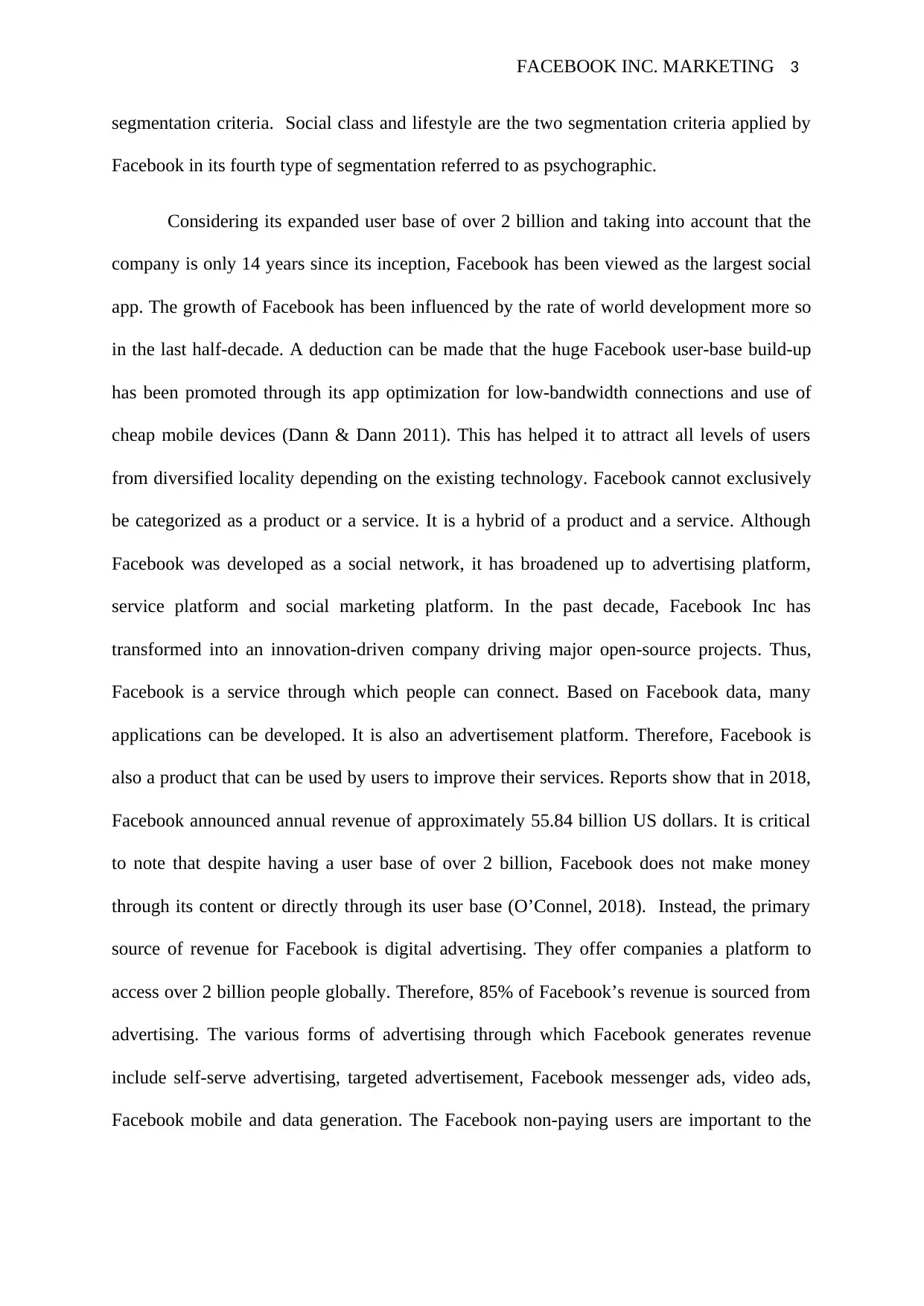
FACEBOOK INC. MARKETING 3
segmentation criteria. Social class and lifestyle are the two segmentation criteria applied by
Facebook in its fourth type of segmentation referred to as psychographic.
Considering its expanded user base of over 2 billion and taking into account that the
company is only 14 years since its inception, Facebook has been viewed as the largest social
app. The growth of Facebook has been influenced by the rate of world development more so
in the last half-decade. A deduction can be made that the huge Facebook user-base build-up
has been promoted through its app optimization for low-bandwidth connections and use of
cheap mobile devices (Dann & Dann 2011). This has helped it to attract all levels of users
from diversified locality depending on the existing technology. Facebook cannot exclusively
be categorized as a product or a service. It is a hybrid of a product and a service. Although
Facebook was developed as a social network, it has broadened up to advertising platform,
service platform and social marketing platform. In the past decade, Facebook Inc has
transformed into an innovation-driven company driving major open-source projects. Thus,
Facebook is a service through which people can connect. Based on Facebook data, many
applications can be developed. It is also an advertisement platform. Therefore, Facebook is
also a product that can be used by users to improve their services. Reports show that in 2018,
Facebook announced annual revenue of approximately 55.84 billion US dollars. It is critical
to note that despite having a user base of over 2 billion, Facebook does not make money
through its content or directly through its user base (O’Connel, 2018). Instead, the primary
source of revenue for Facebook is digital advertising. They offer companies a platform to
access over 2 billion people globally. Therefore, 85% of Facebook’s revenue is sourced from
advertising. The various forms of advertising through which Facebook generates revenue
include self-serve advertising, targeted advertisement, Facebook messenger ads, video ads,
Facebook mobile and data generation. The Facebook non-paying users are important to the
segmentation criteria. Social class and lifestyle are the two segmentation criteria applied by
Facebook in its fourth type of segmentation referred to as psychographic.
Considering its expanded user base of over 2 billion and taking into account that the
company is only 14 years since its inception, Facebook has been viewed as the largest social
app. The growth of Facebook has been influenced by the rate of world development more so
in the last half-decade. A deduction can be made that the huge Facebook user-base build-up
has been promoted through its app optimization for low-bandwidth connections and use of
cheap mobile devices (Dann & Dann 2011). This has helped it to attract all levels of users
from diversified locality depending on the existing technology. Facebook cannot exclusively
be categorized as a product or a service. It is a hybrid of a product and a service. Although
Facebook was developed as a social network, it has broadened up to advertising platform,
service platform and social marketing platform. In the past decade, Facebook Inc has
transformed into an innovation-driven company driving major open-source projects. Thus,
Facebook is a service through which people can connect. Based on Facebook data, many
applications can be developed. It is also an advertisement platform. Therefore, Facebook is
also a product that can be used by users to improve their services. Reports show that in 2018,
Facebook announced annual revenue of approximately 55.84 billion US dollars. It is critical
to note that despite having a user base of over 2 billion, Facebook does not make money
through its content or directly through its user base (O’Connel, 2018). Instead, the primary
source of revenue for Facebook is digital advertising. They offer companies a platform to
access over 2 billion people globally. Therefore, 85% of Facebook’s revenue is sourced from
advertising. The various forms of advertising through which Facebook generates revenue
include self-serve advertising, targeted advertisement, Facebook messenger ads, video ads,
Facebook mobile and data generation. The Facebook non-paying users are important to the
⊘ This is a preview!⊘
Do you want full access?
Subscribe today to unlock all pages.

Trusted by 1+ million students worldwide
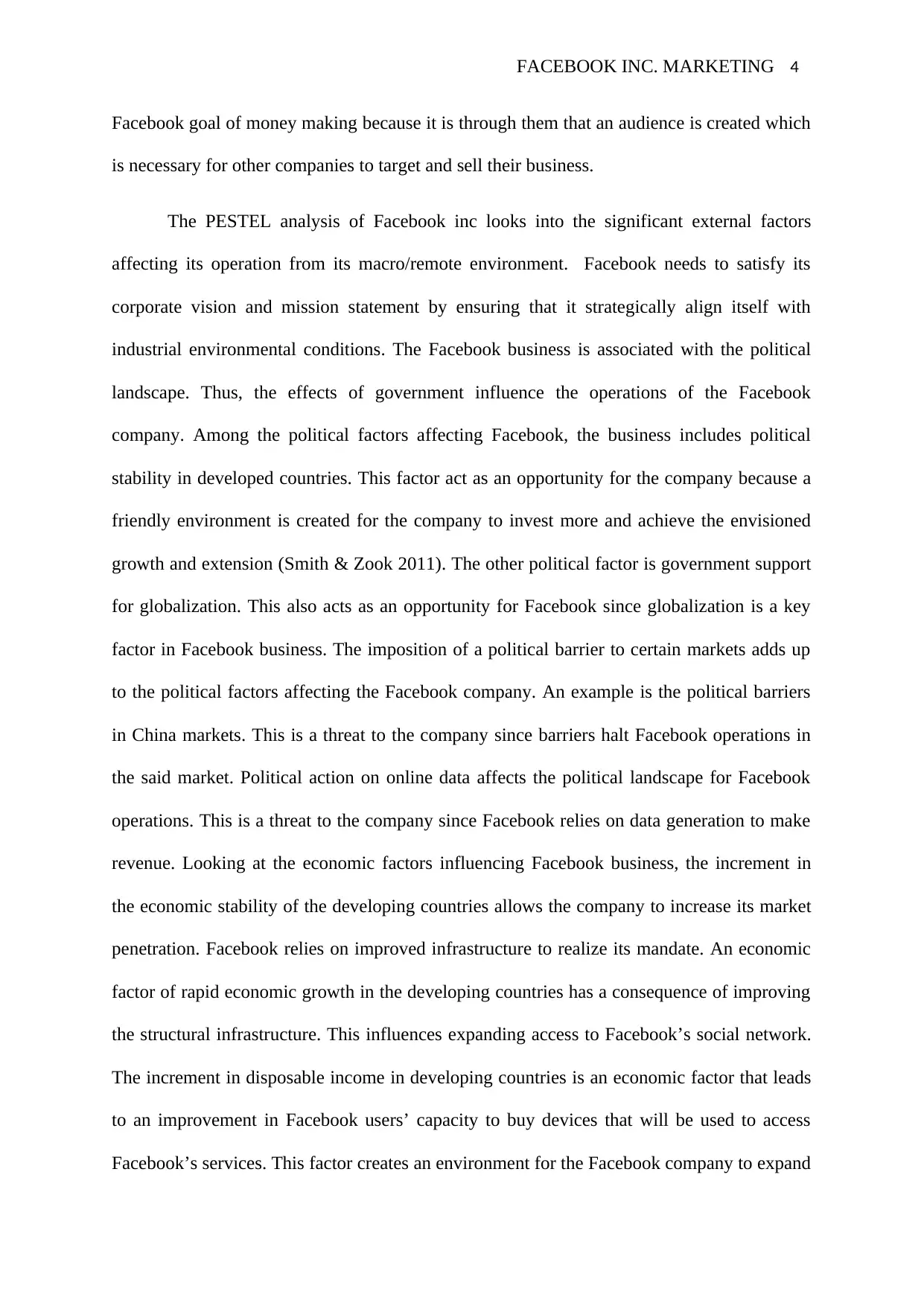
FACEBOOK INC. MARKETING 4
Facebook goal of money making because it is through them that an audience is created which
is necessary for other companies to target and sell their business.
The PESTEL analysis of Facebook inc looks into the significant external factors
affecting its operation from its macro/remote environment. Facebook needs to satisfy its
corporate vision and mission statement by ensuring that it strategically align itself with
industrial environmental conditions. The Facebook business is associated with the political
landscape. Thus, the effects of government influence the operations of the Facebook
company. Among the political factors affecting Facebook, the business includes political
stability in developed countries. This factor act as an opportunity for the company because a
friendly environment is created for the company to invest more and achieve the envisioned
growth and extension (Smith & Zook 2011). The other political factor is government support
for globalization. This also acts as an opportunity for Facebook since globalization is a key
factor in Facebook business. The imposition of a political barrier to certain markets adds up
to the political factors affecting the Facebook company. An example is the political barriers
in China markets. This is a threat to the company since barriers halt Facebook operations in
the said market. Political action on online data affects the political landscape for Facebook
operations. This is a threat to the company since Facebook relies on data generation to make
revenue. Looking at the economic factors influencing Facebook business, the increment in
the economic stability of the developing countries allows the company to increase its market
penetration. Facebook relies on improved infrastructure to realize its mandate. An economic
factor of rapid economic growth in the developing countries has a consequence of improving
the structural infrastructure. This influences expanding access to Facebook’s social network.
The increment in disposable income in developing countries is an economic factor that leads
to an improvement in Facebook users’ capacity to buy devices that will be used to access
Facebook’s services. This factor creates an environment for the Facebook company to expand
Facebook goal of money making because it is through them that an audience is created which
is necessary for other companies to target and sell their business.
The PESTEL analysis of Facebook inc looks into the significant external factors
affecting its operation from its macro/remote environment. Facebook needs to satisfy its
corporate vision and mission statement by ensuring that it strategically align itself with
industrial environmental conditions. The Facebook business is associated with the political
landscape. Thus, the effects of government influence the operations of the Facebook
company. Among the political factors affecting Facebook, the business includes political
stability in developed countries. This factor act as an opportunity for the company because a
friendly environment is created for the company to invest more and achieve the envisioned
growth and extension (Smith & Zook 2011). The other political factor is government support
for globalization. This also acts as an opportunity for Facebook since globalization is a key
factor in Facebook business. The imposition of a political barrier to certain markets adds up
to the political factors affecting the Facebook company. An example is the political barriers
in China markets. This is a threat to the company since barriers halt Facebook operations in
the said market. Political action on online data affects the political landscape for Facebook
operations. This is a threat to the company since Facebook relies on data generation to make
revenue. Looking at the economic factors influencing Facebook business, the increment in
the economic stability of the developing countries allows the company to increase its market
penetration. Facebook relies on improved infrastructure to realize its mandate. An economic
factor of rapid economic growth in the developing countries has a consequence of improving
the structural infrastructure. This influences expanding access to Facebook’s social network.
The increment in disposable income in developing countries is an economic factor that leads
to an improvement in Facebook users’ capacity to buy devices that will be used to access
Facebook’s services. This factor creates an environment for the Facebook company to expand
Paraphrase This Document
Need a fresh take? Get an instant paraphrase of this document with our AI Paraphraser
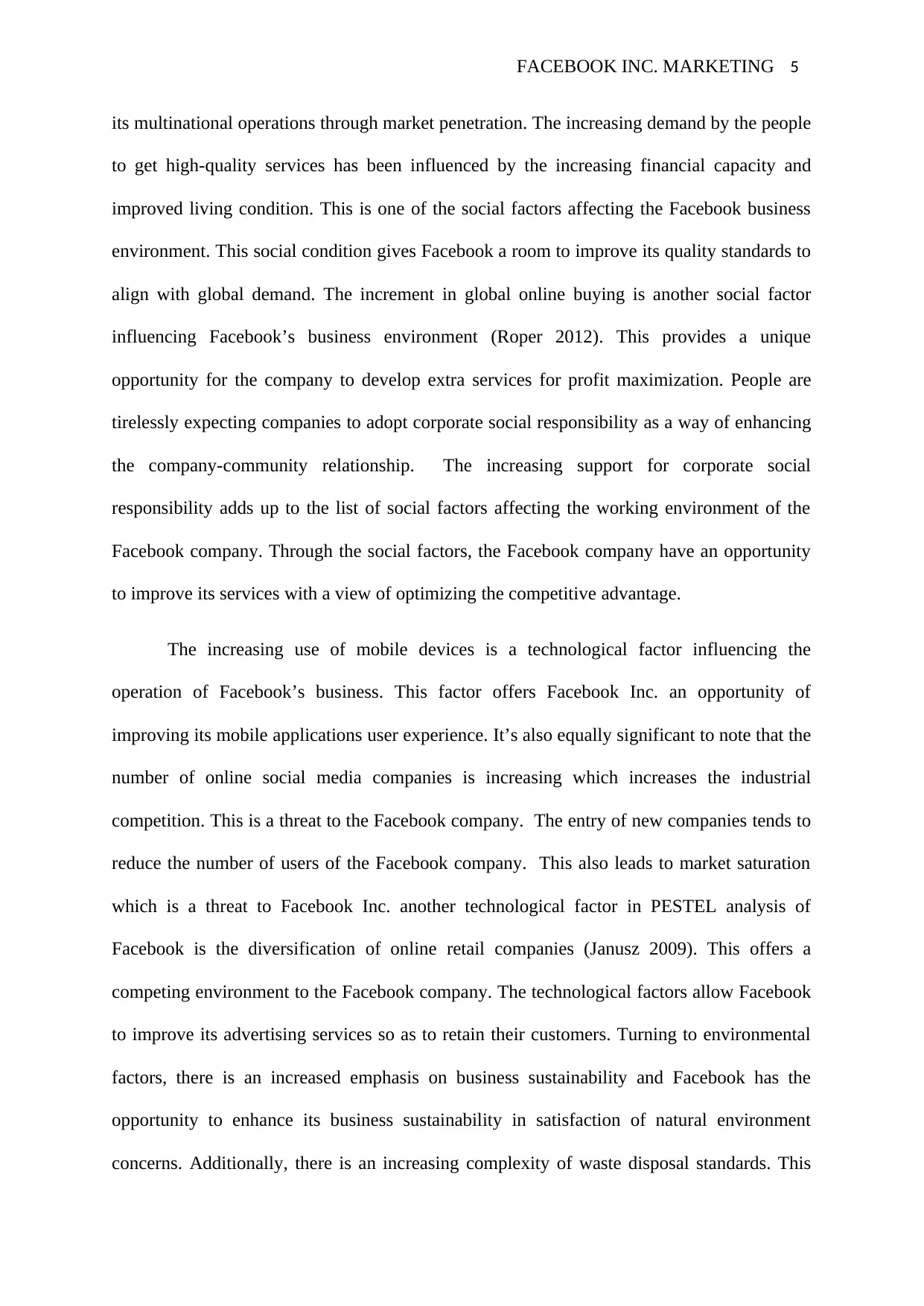
FACEBOOK INC. MARKETING 5
its multinational operations through market penetration. The increasing demand by the people
to get high-quality services has been influenced by the increasing financial capacity and
improved living condition. This is one of the social factors affecting the Facebook business
environment. This social condition gives Facebook a room to improve its quality standards to
align with global demand. The increment in global online buying is another social factor
influencing Facebook’s business environment (Roper 2012). This provides a unique
opportunity for the company to develop extra services for profit maximization. People are
tirelessly expecting companies to adopt corporate social responsibility as a way of enhancing
the company-community relationship. The increasing support for corporate social
responsibility adds up to the list of social factors affecting the working environment of the
Facebook company. Through the social factors, the Facebook company have an opportunity
to improve its services with a view of optimizing the competitive advantage.
The increasing use of mobile devices is a technological factor influencing the
operation of Facebook’s business. This factor offers Facebook Inc. an opportunity of
improving its mobile applications user experience. It’s also equally significant to note that the
number of online social media companies is increasing which increases the industrial
competition. This is a threat to the Facebook company. The entry of new companies tends to
reduce the number of users of the Facebook company. This also leads to market saturation
which is a threat to Facebook Inc. another technological factor in PESTEL analysis of
Facebook is the diversification of online retail companies (Janusz 2009). This offers a
competing environment to the Facebook company. The technological factors allow Facebook
to improve its advertising services so as to retain their customers. Turning to environmental
factors, there is an increased emphasis on business sustainability and Facebook has the
opportunity to enhance its business sustainability in satisfaction of natural environment
concerns. Additionally, there is an increasing complexity of waste disposal standards. This
its multinational operations through market penetration. The increasing demand by the people
to get high-quality services has been influenced by the increasing financial capacity and
improved living condition. This is one of the social factors affecting the Facebook business
environment. This social condition gives Facebook a room to improve its quality standards to
align with global demand. The increment in global online buying is another social factor
influencing Facebook’s business environment (Roper 2012). This provides a unique
opportunity for the company to develop extra services for profit maximization. People are
tirelessly expecting companies to adopt corporate social responsibility as a way of enhancing
the company-community relationship. The increasing support for corporate social
responsibility adds up to the list of social factors affecting the working environment of the
Facebook company. Through the social factors, the Facebook company have an opportunity
to improve its services with a view of optimizing the competitive advantage.
The increasing use of mobile devices is a technological factor influencing the
operation of Facebook’s business. This factor offers Facebook Inc. an opportunity of
improving its mobile applications user experience. It’s also equally significant to note that the
number of online social media companies is increasing which increases the industrial
competition. This is a threat to the Facebook company. The entry of new companies tends to
reduce the number of users of the Facebook company. This also leads to market saturation
which is a threat to Facebook Inc. another technological factor in PESTEL analysis of
Facebook is the diversification of online retail companies (Janusz 2009). This offers a
competing environment to the Facebook company. The technological factors allow Facebook
to improve its advertising services so as to retain their customers. Turning to environmental
factors, there is an increased emphasis on business sustainability and Facebook has the
opportunity to enhance its business sustainability in satisfaction of natural environment
concerns. Additionally, there is an increasing complexity of waste disposal standards. This
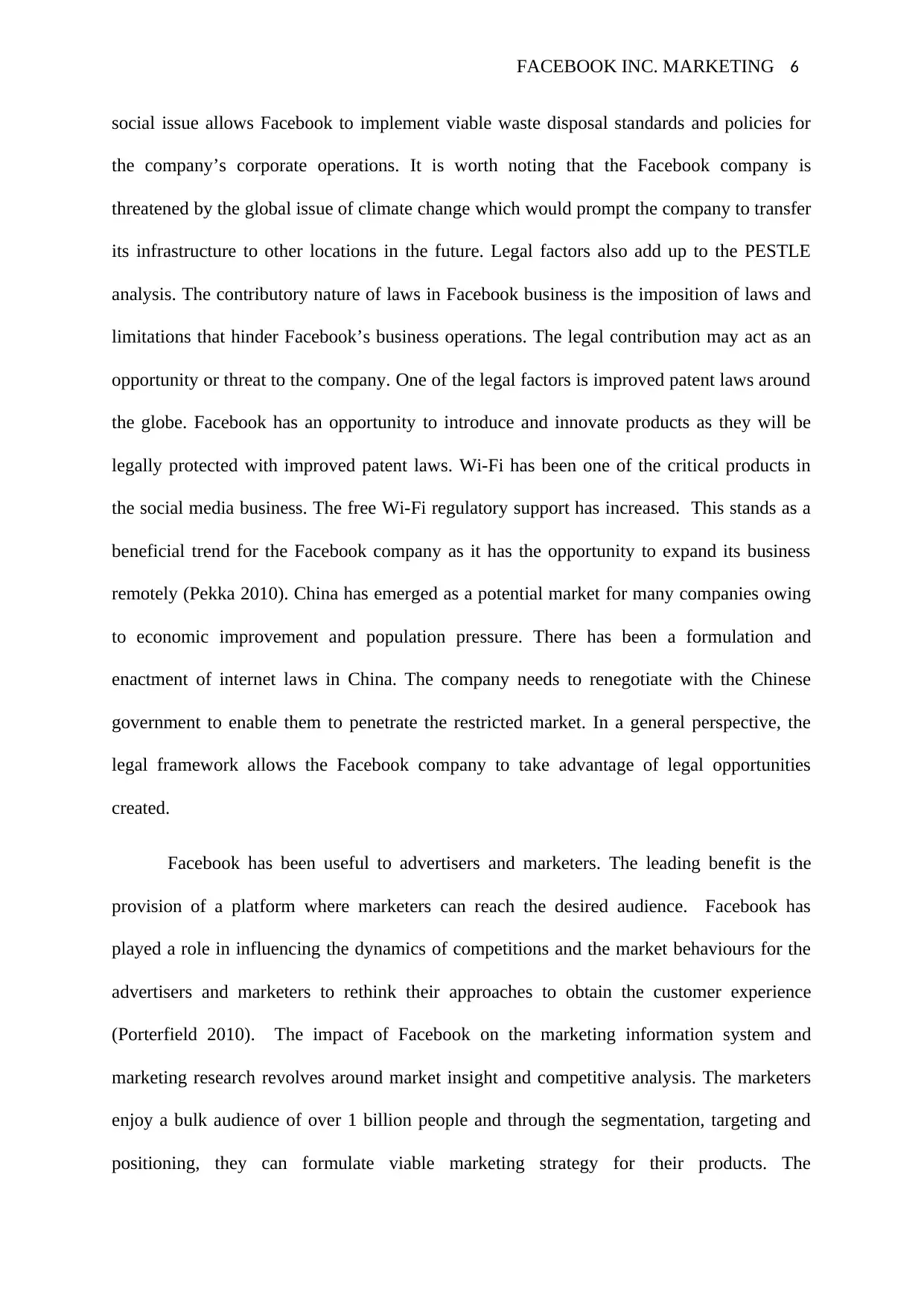
FACEBOOK INC. MARKETING 6
social issue allows Facebook to implement viable waste disposal standards and policies for
the company’s corporate operations. It is worth noting that the Facebook company is
threatened by the global issue of climate change which would prompt the company to transfer
its infrastructure to other locations in the future. Legal factors also add up to the PESTLE
analysis. The contributory nature of laws in Facebook business is the imposition of laws and
limitations that hinder Facebook’s business operations. The legal contribution may act as an
opportunity or threat to the company. One of the legal factors is improved patent laws around
the globe. Facebook has an opportunity to introduce and innovate products as they will be
legally protected with improved patent laws. Wi-Fi has been one of the critical products in
the social media business. The free Wi-Fi regulatory support has increased. This stands as a
beneficial trend for the Facebook company as it has the opportunity to expand its business
remotely (Pekka 2010). China has emerged as a potential market for many companies owing
to economic improvement and population pressure. There has been a formulation and
enactment of internet laws in China. The company needs to renegotiate with the Chinese
government to enable them to penetrate the restricted market. In a general perspective, the
legal framework allows the Facebook company to take advantage of legal opportunities
created.
Facebook has been useful to advertisers and marketers. The leading benefit is the
provision of a platform where marketers can reach the desired audience. Facebook has
played a role in influencing the dynamics of competitions and the market behaviours for the
advertisers and marketers to rethink their approaches to obtain the customer experience
(Porterfield 2010). The impact of Facebook on the marketing information system and
marketing research revolves around market insight and competitive analysis. The marketers
enjoy a bulk audience of over 1 billion people and through the segmentation, targeting and
positioning, they can formulate viable marketing strategy for their products. The
social issue allows Facebook to implement viable waste disposal standards and policies for
the company’s corporate operations. It is worth noting that the Facebook company is
threatened by the global issue of climate change which would prompt the company to transfer
its infrastructure to other locations in the future. Legal factors also add up to the PESTLE
analysis. The contributory nature of laws in Facebook business is the imposition of laws and
limitations that hinder Facebook’s business operations. The legal contribution may act as an
opportunity or threat to the company. One of the legal factors is improved patent laws around
the globe. Facebook has an opportunity to introduce and innovate products as they will be
legally protected with improved patent laws. Wi-Fi has been one of the critical products in
the social media business. The free Wi-Fi regulatory support has increased. This stands as a
beneficial trend for the Facebook company as it has the opportunity to expand its business
remotely (Pekka 2010). China has emerged as a potential market for many companies owing
to economic improvement and population pressure. There has been a formulation and
enactment of internet laws in China. The company needs to renegotiate with the Chinese
government to enable them to penetrate the restricted market. In a general perspective, the
legal framework allows the Facebook company to take advantage of legal opportunities
created.
Facebook has been useful to advertisers and marketers. The leading benefit is the
provision of a platform where marketers can reach the desired audience. Facebook has
played a role in influencing the dynamics of competitions and the market behaviours for the
advertisers and marketers to rethink their approaches to obtain the customer experience
(Porterfield 2010). The impact of Facebook on the marketing information system and
marketing research revolves around market insight and competitive analysis. The marketers
enjoy a bulk audience of over 1 billion people and through the segmentation, targeting and
positioning, they can formulate viable marketing strategy for their products. The
⊘ This is a preview!⊘
Do you want full access?
Subscribe today to unlock all pages.

Trusted by 1+ million students worldwide
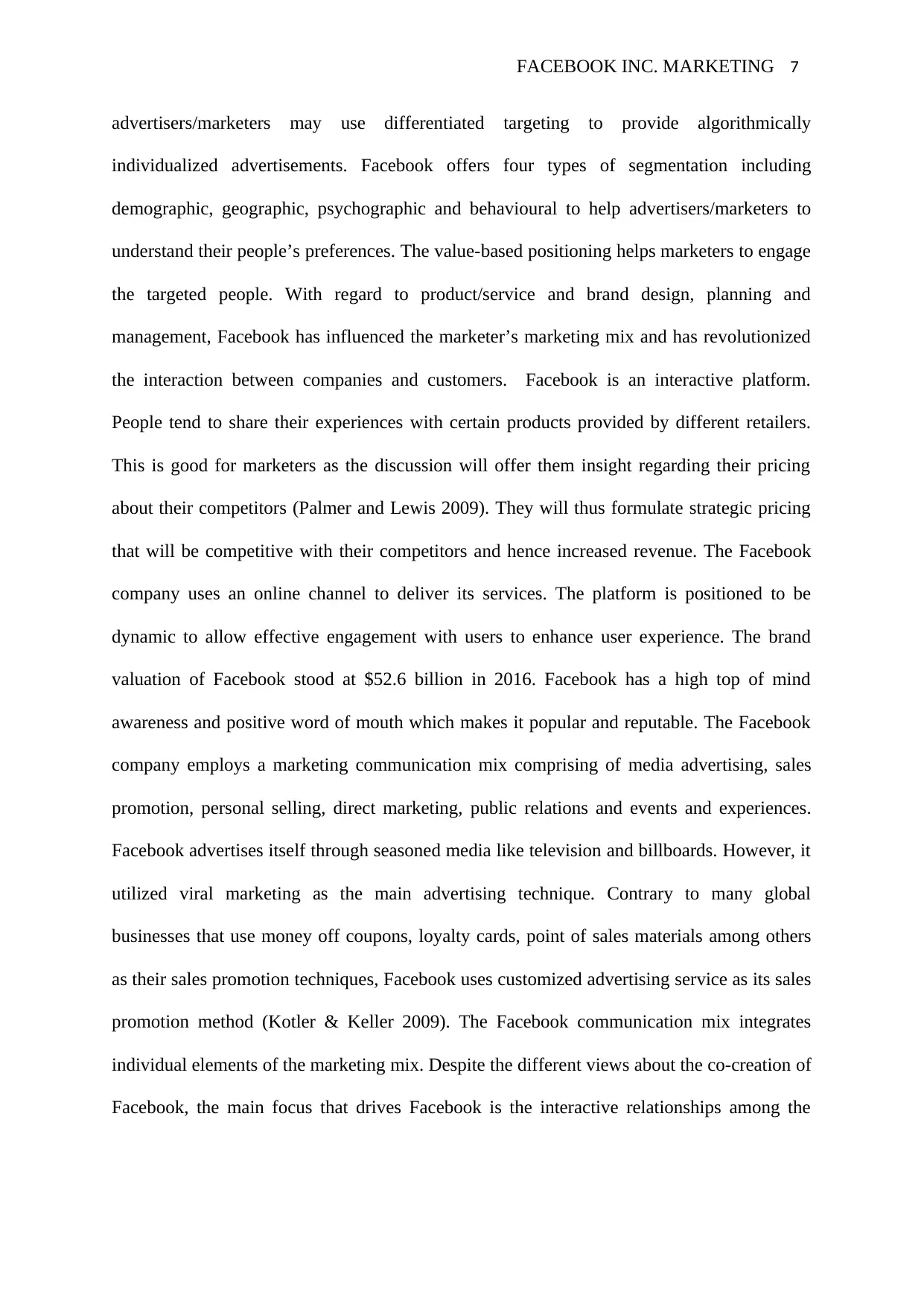
FACEBOOK INC. MARKETING 7
advertisers/marketers may use differentiated targeting to provide algorithmically
individualized advertisements. Facebook offers four types of segmentation including
demographic, geographic, psychographic and behavioural to help advertisers/marketers to
understand their people’s preferences. The value-based positioning helps marketers to engage
the targeted people. With regard to product/service and brand design, planning and
management, Facebook has influenced the marketer’s marketing mix and has revolutionized
the interaction between companies and customers. Facebook is an interactive platform.
People tend to share their experiences with certain products provided by different retailers.
This is good for marketers as the discussion will offer them insight regarding their pricing
about their competitors (Palmer and Lewis 2009). They will thus formulate strategic pricing
that will be competitive with their competitors and hence increased revenue. The Facebook
company uses an online channel to deliver its services. The platform is positioned to be
dynamic to allow effective engagement with users to enhance user experience. The brand
valuation of Facebook stood at $52.6 billion in 2016. Facebook has a high top of mind
awareness and positive word of mouth which makes it popular and reputable. The Facebook
company employs a marketing communication mix comprising of media advertising, sales
promotion, personal selling, direct marketing, public relations and events and experiences.
Facebook advertises itself through seasoned media like television and billboards. However, it
utilized viral marketing as the main advertising technique. Contrary to many global
businesses that use money off coupons, loyalty cards, point of sales materials among others
as their sales promotion techniques, Facebook uses customized advertising service as its sales
promotion method (Kotler & Keller 2009). The Facebook communication mix integrates
individual elements of the marketing mix. Despite the different views about the co-creation of
Facebook, the main focus that drives Facebook is the interactive relationships among the
advertisers/marketers may use differentiated targeting to provide algorithmically
individualized advertisements. Facebook offers four types of segmentation including
demographic, geographic, psychographic and behavioural to help advertisers/marketers to
understand their people’s preferences. The value-based positioning helps marketers to engage
the targeted people. With regard to product/service and brand design, planning and
management, Facebook has influenced the marketer’s marketing mix and has revolutionized
the interaction between companies and customers. Facebook is an interactive platform.
People tend to share their experiences with certain products provided by different retailers.
This is good for marketers as the discussion will offer them insight regarding their pricing
about their competitors (Palmer and Lewis 2009). They will thus formulate strategic pricing
that will be competitive with their competitors and hence increased revenue. The Facebook
company uses an online channel to deliver its services. The platform is positioned to be
dynamic to allow effective engagement with users to enhance user experience. The brand
valuation of Facebook stood at $52.6 billion in 2016. Facebook has a high top of mind
awareness and positive word of mouth which makes it popular and reputable. The Facebook
company employs a marketing communication mix comprising of media advertising, sales
promotion, personal selling, direct marketing, public relations and events and experiences.
Facebook advertises itself through seasoned media like television and billboards. However, it
utilized viral marketing as the main advertising technique. Contrary to many global
businesses that use money off coupons, loyalty cards, point of sales materials among others
as their sales promotion techniques, Facebook uses customized advertising service as its sales
promotion method (Kotler & Keller 2009). The Facebook communication mix integrates
individual elements of the marketing mix. Despite the different views about the co-creation of
Facebook, the main focus that drives Facebook is the interactive relationships among the
Paraphrase This Document
Need a fresh take? Get an instant paraphrase of this document with our AI Paraphraser
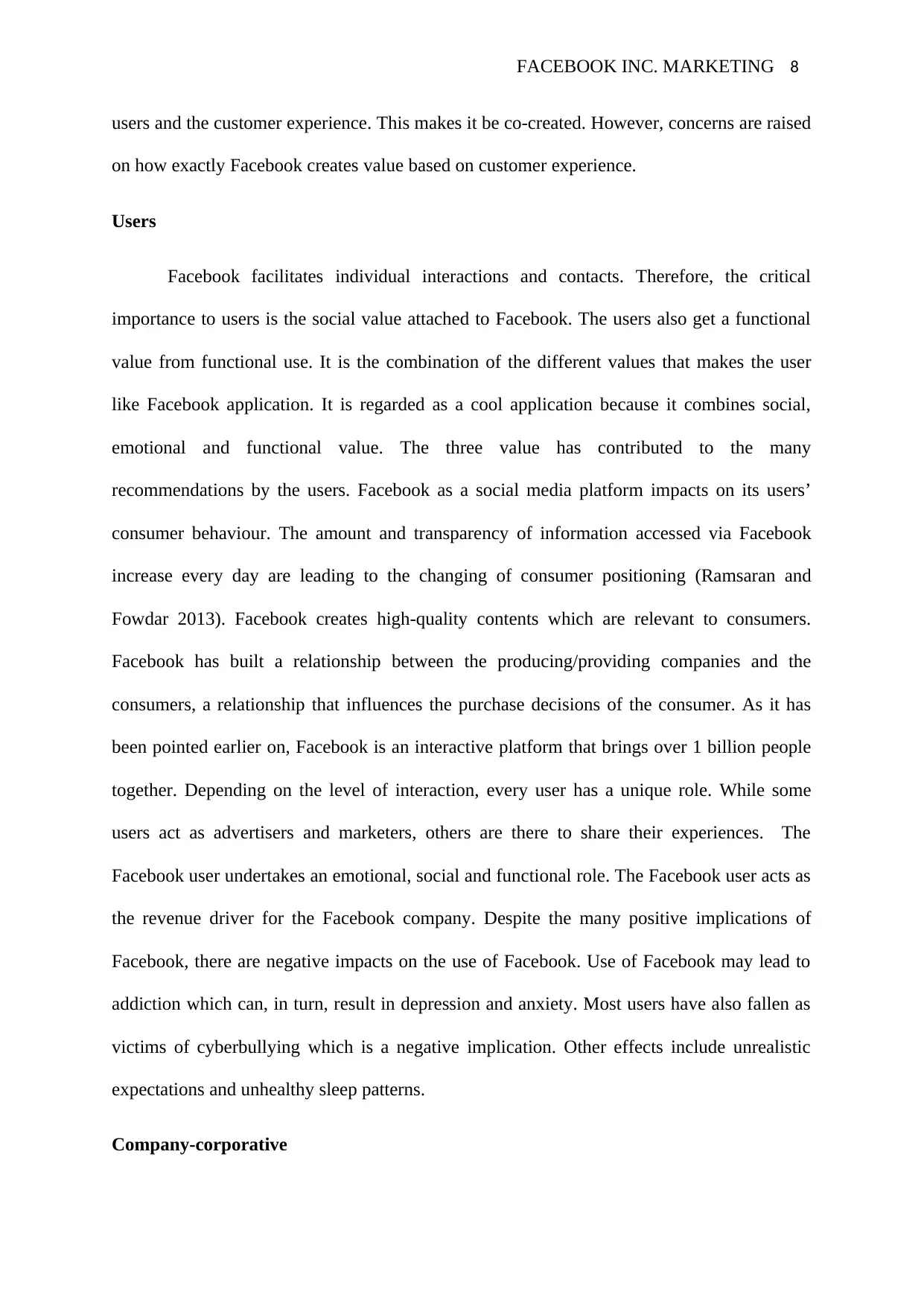
FACEBOOK INC. MARKETING 8
users and the customer experience. This makes it be co-created. However, concerns are raised
on how exactly Facebook creates value based on customer experience.
Users
Facebook facilitates individual interactions and contacts. Therefore, the critical
importance to users is the social value attached to Facebook. The users also get a functional
value from functional use. It is the combination of the different values that makes the user
like Facebook application. It is regarded as a cool application because it combines social,
emotional and functional value. The three value has contributed to the many
recommendations by the users. Facebook as a social media platform impacts on its users’
consumer behaviour. The amount and transparency of information accessed via Facebook
increase every day are leading to the changing of consumer positioning (Ramsaran and
Fowdar 2013). Facebook creates high-quality contents which are relevant to consumers.
Facebook has built a relationship between the producing/providing companies and the
consumers, a relationship that influences the purchase decisions of the consumer. As it has
been pointed earlier on, Facebook is an interactive platform that brings over 1 billion people
together. Depending on the level of interaction, every user has a unique role. While some
users act as advertisers and marketers, others are there to share their experiences. The
Facebook user undertakes an emotional, social and functional role. The Facebook user acts as
the revenue driver for the Facebook company. Despite the many positive implications of
Facebook, there are negative impacts on the use of Facebook. Use of Facebook may lead to
addiction which can, in turn, result in depression and anxiety. Most users have also fallen as
victims of cyberbullying which is a negative implication. Other effects include unrealistic
expectations and unhealthy sleep patterns.
Company-corporative
users and the customer experience. This makes it be co-created. However, concerns are raised
on how exactly Facebook creates value based on customer experience.
Users
Facebook facilitates individual interactions and contacts. Therefore, the critical
importance to users is the social value attached to Facebook. The users also get a functional
value from functional use. It is the combination of the different values that makes the user
like Facebook application. It is regarded as a cool application because it combines social,
emotional and functional value. The three value has contributed to the many
recommendations by the users. Facebook as a social media platform impacts on its users’
consumer behaviour. The amount and transparency of information accessed via Facebook
increase every day are leading to the changing of consumer positioning (Ramsaran and
Fowdar 2013). Facebook creates high-quality contents which are relevant to consumers.
Facebook has built a relationship between the producing/providing companies and the
consumers, a relationship that influences the purchase decisions of the consumer. As it has
been pointed earlier on, Facebook is an interactive platform that brings over 1 billion people
together. Depending on the level of interaction, every user has a unique role. While some
users act as advertisers and marketers, others are there to share their experiences. The
Facebook user undertakes an emotional, social and functional role. The Facebook user acts as
the revenue driver for the Facebook company. Despite the many positive implications of
Facebook, there are negative impacts on the use of Facebook. Use of Facebook may lead to
addiction which can, in turn, result in depression and anxiety. Most users have also fallen as
victims of cyberbullying which is a negative implication. Other effects include unrealistic
expectations and unhealthy sleep patterns.
Company-corporative
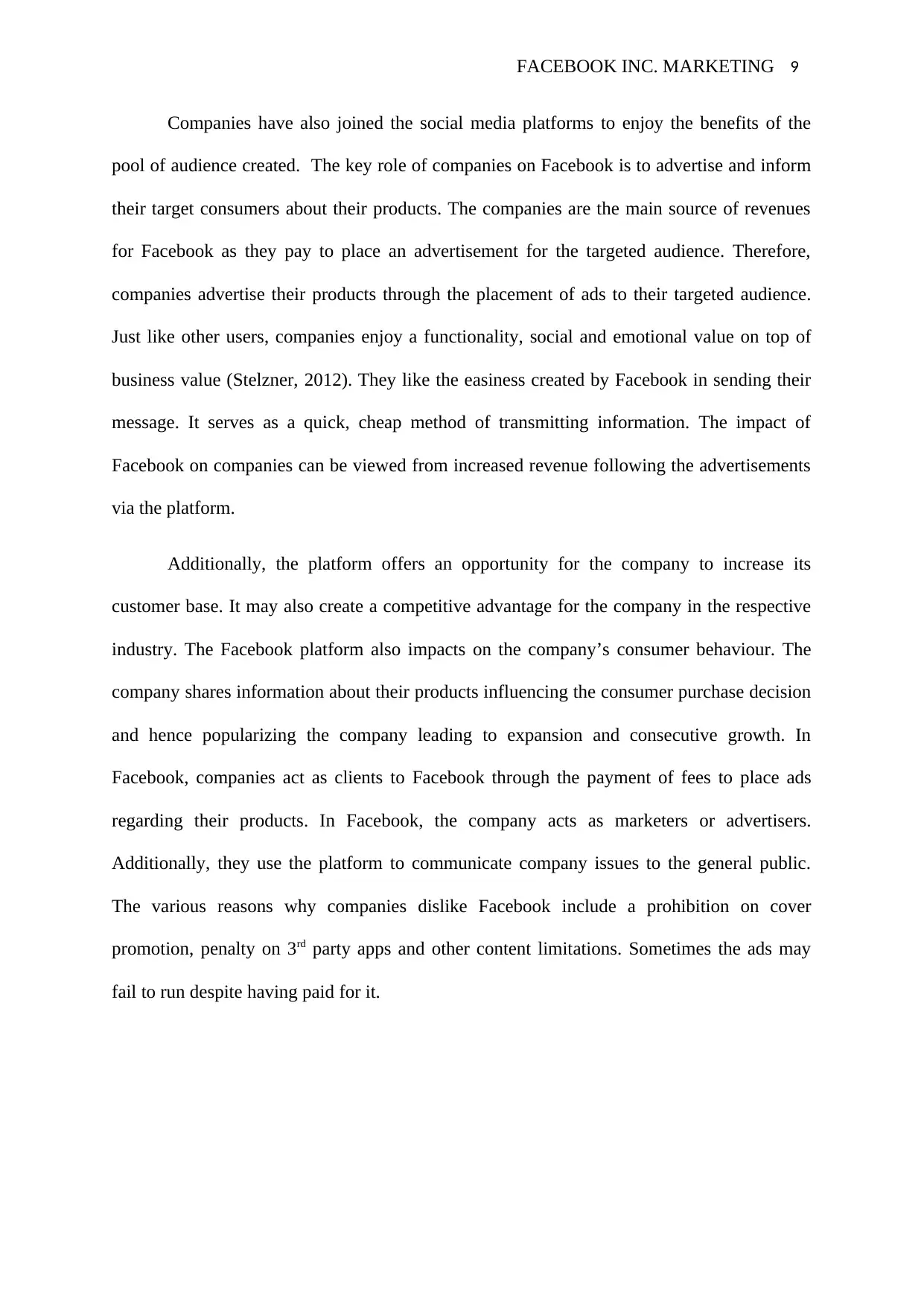
FACEBOOK INC. MARKETING 9
Companies have also joined the social media platforms to enjoy the benefits of the
pool of audience created. The key role of companies on Facebook is to advertise and inform
their target consumers about their products. The companies are the main source of revenues
for Facebook as they pay to place an advertisement for the targeted audience. Therefore,
companies advertise their products through the placement of ads to their targeted audience.
Just like other users, companies enjoy a functionality, social and emotional value on top of
business value (Stelzner, 2012). They like the easiness created by Facebook in sending their
message. It serves as a quick, cheap method of transmitting information. The impact of
Facebook on companies can be viewed from increased revenue following the advertisements
via the platform.
Additionally, the platform offers an opportunity for the company to increase its
customer base. It may also create a competitive advantage for the company in the respective
industry. The Facebook platform also impacts on the company’s consumer behaviour. The
company shares information about their products influencing the consumer purchase decision
and hence popularizing the company leading to expansion and consecutive growth. In
Facebook, companies act as clients to Facebook through the payment of fees to place ads
regarding their products. In Facebook, the company acts as marketers or advertisers.
Additionally, they use the platform to communicate company issues to the general public.
The various reasons why companies dislike Facebook include a prohibition on cover
promotion, penalty on 3rd party apps and other content limitations. Sometimes the ads may
fail to run despite having paid for it.
Companies have also joined the social media platforms to enjoy the benefits of the
pool of audience created. The key role of companies on Facebook is to advertise and inform
their target consumers about their products. The companies are the main source of revenues
for Facebook as they pay to place an advertisement for the targeted audience. Therefore,
companies advertise their products through the placement of ads to their targeted audience.
Just like other users, companies enjoy a functionality, social and emotional value on top of
business value (Stelzner, 2012). They like the easiness created by Facebook in sending their
message. It serves as a quick, cheap method of transmitting information. The impact of
Facebook on companies can be viewed from increased revenue following the advertisements
via the platform.
Additionally, the platform offers an opportunity for the company to increase its
customer base. It may also create a competitive advantage for the company in the respective
industry. The Facebook platform also impacts on the company’s consumer behaviour. The
company shares information about their products influencing the consumer purchase decision
and hence popularizing the company leading to expansion and consecutive growth. In
Facebook, companies act as clients to Facebook through the payment of fees to place ads
regarding their products. In Facebook, the company acts as marketers or advertisers.
Additionally, they use the platform to communicate company issues to the general public.
The various reasons why companies dislike Facebook include a prohibition on cover
promotion, penalty on 3rd party apps and other content limitations. Sometimes the ads may
fail to run despite having paid for it.
⊘ This is a preview!⊘
Do you want full access?
Subscribe today to unlock all pages.

Trusted by 1+ million students worldwide
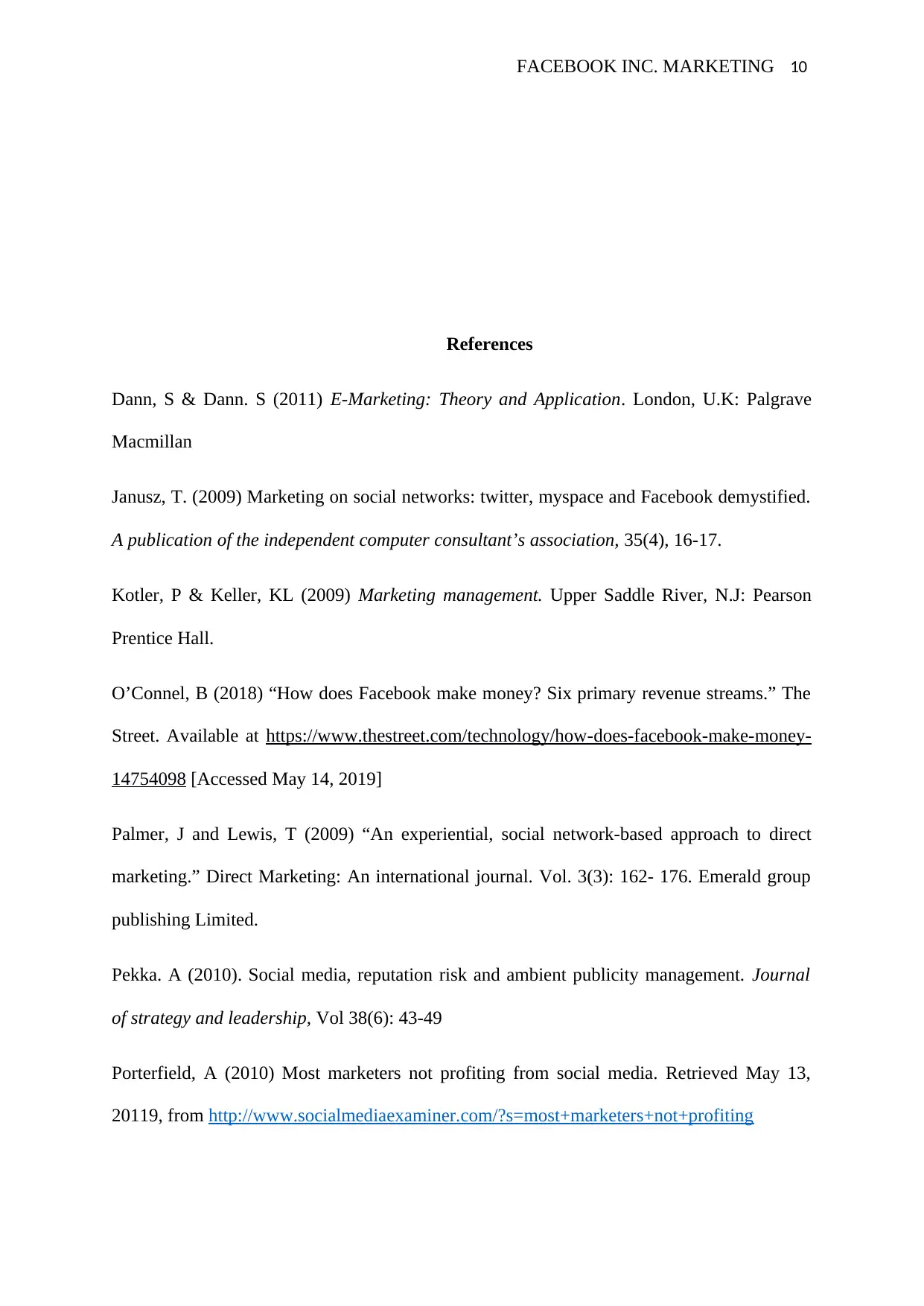
FACEBOOK INC. MARKETING 10
References
Dann, S & Dann. S (2011) E-Marketing: Theory and Application. London, U.K: Palgrave
Macmillan
Janusz, T. (2009) Marketing on social networks: twitter, myspace and Facebook demystified.
A publication of the independent computer consultant’s association, 35(4), 16-17.
Kotler, P & Keller, KL (2009) Marketing management. Upper Saddle River, N.J: Pearson
Prentice Hall.
O’Connel, B (2018) “How does Facebook make money? Six primary revenue streams.” The
Street. Available at https://www.thestreet.com/technology/how-does-facebook-make-money-
14754098 [Accessed May 14, 2019]
Palmer, J and Lewis, T (2009) “An experiential, social network-based approach to direct
marketing.” Direct Marketing: An international journal. Vol. 3(3): 162- 176. Emerald group
publishing Limited.
Pekka. A (2010). Social media, reputation risk and ambient publicity management. Journal
of strategy and leadership, Vol 38(6): 43-49
Porterfield, A (2010) Most marketers not profiting from social media. Retrieved May 13,
20119, from http://www.socialmediaexaminer.com/?s=most+marketers+not+profiting
References
Dann, S & Dann. S (2011) E-Marketing: Theory and Application. London, U.K: Palgrave
Macmillan
Janusz, T. (2009) Marketing on social networks: twitter, myspace and Facebook demystified.
A publication of the independent computer consultant’s association, 35(4), 16-17.
Kotler, P & Keller, KL (2009) Marketing management. Upper Saddle River, N.J: Pearson
Prentice Hall.
O’Connel, B (2018) “How does Facebook make money? Six primary revenue streams.” The
Street. Available at https://www.thestreet.com/technology/how-does-facebook-make-money-
14754098 [Accessed May 14, 2019]
Palmer, J and Lewis, T (2009) “An experiential, social network-based approach to direct
marketing.” Direct Marketing: An international journal. Vol. 3(3): 162- 176. Emerald group
publishing Limited.
Pekka. A (2010). Social media, reputation risk and ambient publicity management. Journal
of strategy and leadership, Vol 38(6): 43-49
Porterfield, A (2010) Most marketers not profiting from social media. Retrieved May 13,
20119, from http://www.socialmediaexaminer.com/?s=most+marketers+not+profiting
Paraphrase This Document
Need a fresh take? Get an instant paraphrase of this document with our AI Paraphraser
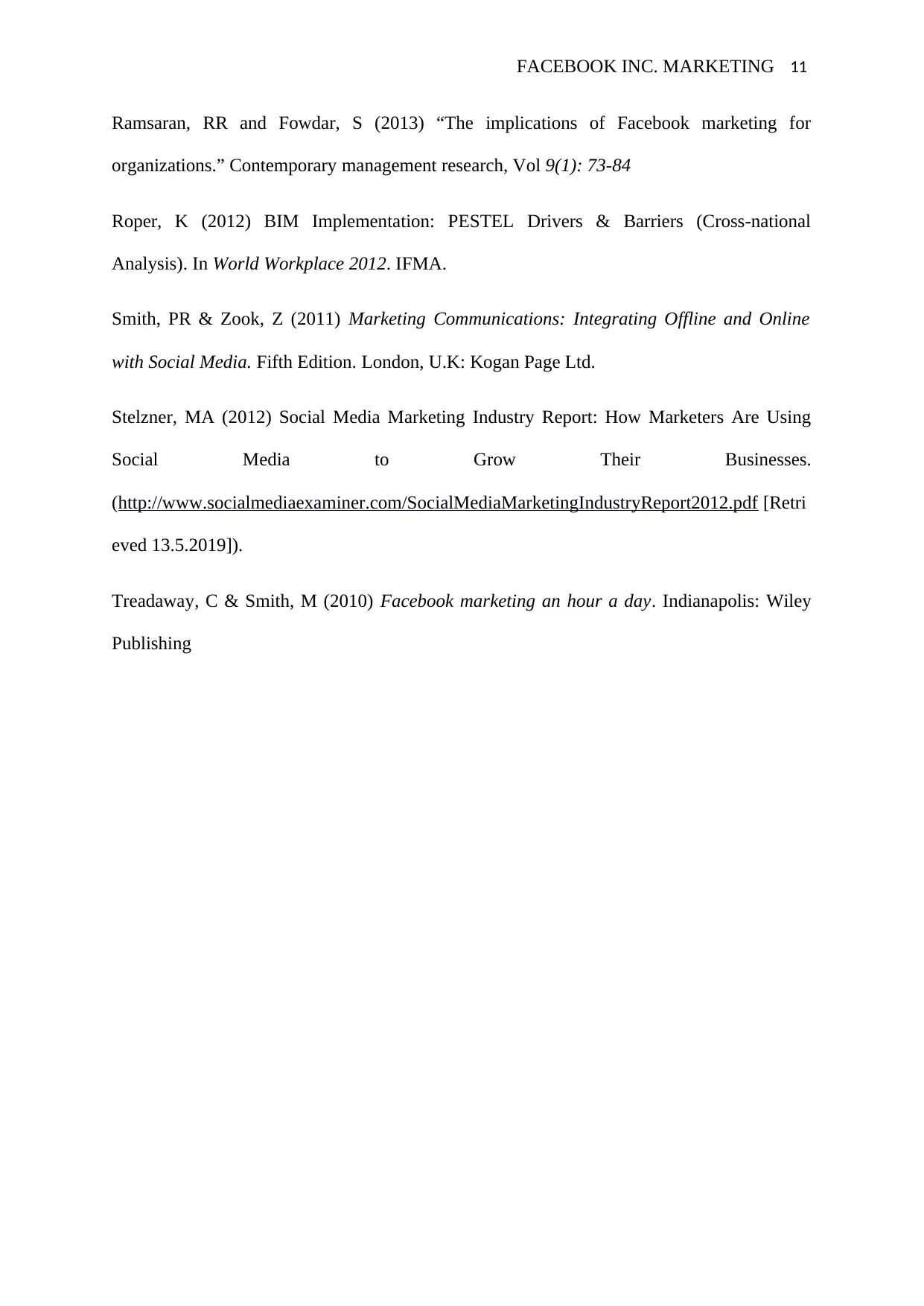
FACEBOOK INC. MARKETING 11
Ramsaran, RR and Fowdar, S (2013) “The implications of Facebook marketing for
organizations.” Contemporary management research, Vol 9(1): 73-84
Roper, K (2012) BIM Implementation: PESTEL Drivers & Barriers (Cross-national
Analysis). In World Workplace 2012. IFMA.
Smith, PR & Zook, Z (2011) Marketing Communications: Integrating Offline and Online
with Social Media. Fifth Edition. London, U.K: Kogan Page Ltd.
Stelzner, MA (2012) Social Media Marketing Industry Report: How Marketers Are Using
Social Media to Grow Their Businesses.
(http://www.socialmediaexaminer.com/SocialMediaMarketingIndustryReport2012.pdf [Retri
eved 13.5.2019]).
Treadaway, C & Smith, M (2010) Facebook marketing an hour a day. Indianapolis: Wiley
Publishing
Ramsaran, RR and Fowdar, S (2013) “The implications of Facebook marketing for
organizations.” Contemporary management research, Vol 9(1): 73-84
Roper, K (2012) BIM Implementation: PESTEL Drivers & Barriers (Cross-national
Analysis). In World Workplace 2012. IFMA.
Smith, PR & Zook, Z (2011) Marketing Communications: Integrating Offline and Online
with Social Media. Fifth Edition. London, U.K: Kogan Page Ltd.
Stelzner, MA (2012) Social Media Marketing Industry Report: How Marketers Are Using
Social Media to Grow Their Businesses.
(http://www.socialmediaexaminer.com/SocialMediaMarketingIndustryReport2012.pdf [Retri
eved 13.5.2019]).
Treadaway, C & Smith, M (2010) Facebook marketing an hour a day. Indianapolis: Wiley
Publishing
1 out of 11
Related Documents
Your All-in-One AI-Powered Toolkit for Academic Success.
+13062052269
info@desklib.com
Available 24*7 on WhatsApp / Email
![[object Object]](/_next/static/media/star-bottom.7253800d.svg)
Unlock your academic potential
Copyright © 2020–2025 A2Z Services. All Rights Reserved. Developed and managed by ZUCOL.





